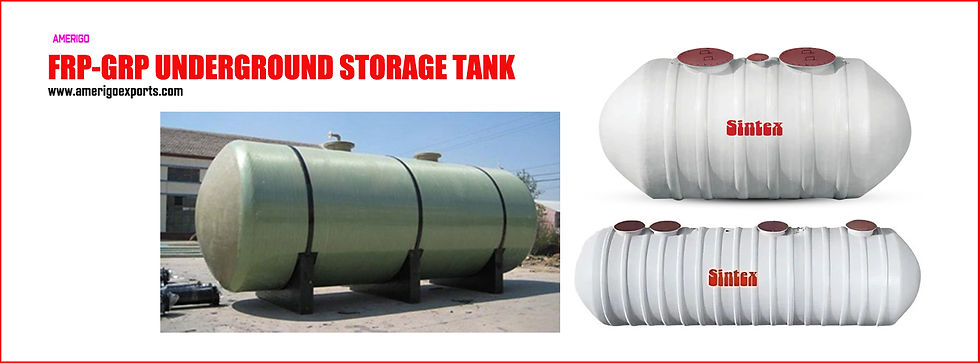Trending special features of FRP (Fiber Reinforced Plastic) and GRP (Glass Reinforced Plastic) storage tanks
- Amerigo Exports
- Nov 13, 2024
- 2 min read
Manufacturers of FRP (Fiber Reinforced Plastic) and GRP (Glass Reinforced Plastic) storage tanks in INDIA produces high quality FRP-GRP tanks which are widely used across various industries due to their durability, corrosion resistance, and lightweight structure. Here are some of their key uses:
1. Chemical Industry
Acid and Alkali Storage: FRP/GRP tanks can resist corrosive chemicals, making them ideal for storing acids, alkalis, and other aggressive chemicals.
Process Tanks: Used in chemical processing where temperature and pressure are moderate, ensuring chemical containment without reaction.
Wastewater Storage: Safe containment of chemical-laden wastewater before treatment or disposal.
2. Water and Wastewater Treatment
Potable Water Storage: GRP tanks are commonly used to store potable (drinking) water because they are non-toxic and corrosion-resistant.
Sewage and Wastewater Tanks: FRP tanks can hold wastewater and sewage, resistant to both chemicals and biological contaminants.
Effluent Treatment: Stores effluents and sludge that need to be treated before release.
3. Food and Beverage Industry
Edible Oil Storage: Safe for storing edible oils, as FRP is resistant to the oxidation and spoilage of contents.
Alcohol and Vinegar Storage: Used to store mildly acidic and alcoholic liquids without contamination.
Brine Storage: Resistant to salt, making them ideal for brine or saltwater storage.
4. Agriculture and Farming
Fertilizer Storage: Stores liquid fertilizers that can be corrosive to metal tanks.
Water Storage for Irrigation: Lightweight and durable for long-term water storage in agriculture.
Feed and Grain Storage: For holding feeds or grains without concerns about corrosion.
5. Oil and Gas Industry
Petroleum Product Storage: Can hold crude oil, gasoline, or other petroleum derivatives.
Saltwater and Produced Water Storage: Used to store brine or water produced from drilling operations.
Corrosive Fluid Storage: Suitable for corrosive by-products or fluids in drilling and refining.
6. Power Plants and Energy Sector
Cooling Water Tanks: For storing cooling water used in thermal and nuclear power plants.
Fuel Storage: Holds various fuels and fuel additives in a corrosion-resistant environment.
Firefighting Water Storage: Often used for firewater tanks due to their durability.
7. Marine Applications
Ballast and Bilge Tanks: In ships and submarines, for holding water ballast and bilge, as they are resistant to saltwater corrosion.
Offshore Platform Storage: Used on offshore platforms for storing drilling fluids, water, and other chemicals.
8. Textile and Dyeing Industry
Dye Solution Tanks: Stores dye solutions and chemicals used in fabric processing.
Effluent Storage: For storing effluents before treatment or disposal, preventing chemical seepage.
These FRP and GRP tanks are popular choices in these sectors because they resist a broad range of chemicals, last longer in corrosive environments, and offer a cost-effective alternative to metals like stainless steel or exotic alloys.





Comments